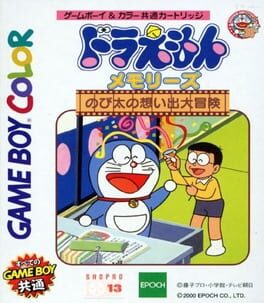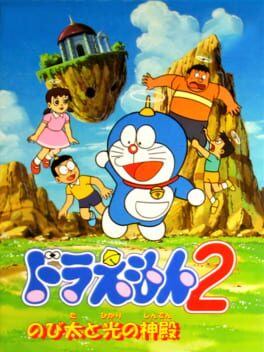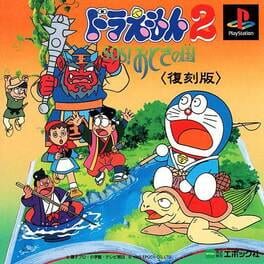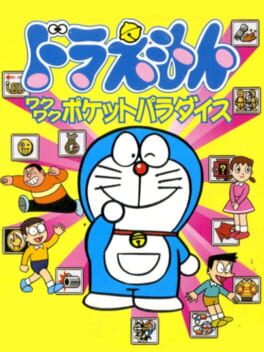

Doraemon: Nobita to Mittsu no Seireiseki is a 3D platform action game for the Nintendo 64. It was released only in Japan in 1997. The game is based on the Japanese manga Doraemon and has two Nintendo 64 sequels, Doraemon 2: Nobita to Hikari no Shinden and Doraemon 3: Nobita no Machi SOS!, both only released in Japan.
Also in series
Reviews View More
Ever since I moved here two years ago, the Book Off across town has had a trilogy of Doraemon games on N64 that I'd never heard of made by Epoch (a game company I'd also never heard of). Being licensed games on a console with a lot of experimental bad games on it, I'd avoided them until a few days ago when I finally decided the 500 yen was worth it to plonk down and have a giggle at how probably bad the first one was. And who knows, maybe it'd be good, as you don't often get three games if you're trash, right? It only took me five hours to beat it, and I did it all in one sitting, but I left my time with Doraemon quite pleasantly surprised by its quality.
The title translates to "Doraemon: Nobita and the Three Spirit Stones", and that really tells you most of what you need to know about the story. The game opens with three mysterious crystals shattering on a hexagram, and an evil looking demon coming forth from the void. Princess Corona (yes, I laughed a lot at her name) of the fairy kingdom goes to her father with worried news of the Demon King's return. The long story short is that only Doraemon and all the tools in his four-dimensional pocket can possibly save the fairy world and the human world, but the Demon King wants his pocket too. In a failed attempt to steal it, Doraemon's tools get spread all over the fairy world, and you'll need to look for them too as you hunt for the shards of the spirit stones as well as the kings of each of the three fairy kingdoms to mend them back together. It's a really simple story that honestly has way too much exposition for how light it is, and in a move I found hilarious, it all ends up being an environmentalist message at the end (the pollution in the human world weakened the elemental link to the spirit stones, so we gotta help the planet to make sure the Demon King doesn't come back UwU). It had a very sort of He-Man-like "look at the camera and tell the children the message of the episode" feel to it in a way that gave me a good giggle X3
The gameplay is a stage-based platformer with a hub world, and it's shockingly enough really solid! Doraemon and his friends are your five playable characters (with Corona playable as a sixth character once you beat the game): Doraemon, Nobita, Shizuka, Takeshi, and Suneo. They all have different weapons as well as different speeds and jump heights (like in Mario 2, but no princess-like hovering in this XD). The only thing is that you need to FIND their weapons, as they're included among of Doraemon's tools (being that their weapons are just some of his tools that they're borrowing to use as weapons). The game has a handful of bosses and three world with 4 stages in each one (and a final boss who is just his own stage). It's a pretty short game, but really solid given that it's only from '97.
The thing with Doraemon's tools is that a lot of them are missable (you can even complete the game without them), so you need to keep your eyes peeled in each level for treasure chests that hide them. Many of the tools that aren't weapons (Doraemon gets an air cannon that's basically a mega buster in the first level, and it's one of the better weapons for sure) are basically keys to play other levels that aren't the first level. Granted you don't gotta know what the items do to have them used as keys, you've just gotta have them. They're all neat little references to stuff in the manga and comics, and the whole presentation in that regard is really cute. The only sorta annoying thing is that a lot of the missable ones are just collectibles with no actual in-game purpose other than to be found, so there was a good while where I was like "but I found an item! What does it unlock!?" despite the fact that it unlocks nothing ^^;
The weapons themselves are fine but suffer from the lack of a MegaMan Legends-style lock on (especially Doraemon's mega buster), so the combat can be kinda frustrating at times, especially for bosses. The levels are all around pretty darn well designed, with each character controlling really well and most jumps feeling very fair and doable without much trial. They don't have maps, but they're small and often linear enough that it's hard to get lost. It doesn't have the sheer flexibility of something like Mario 64, but it plays like a nice, simplified Banjo-Kazooie.
There are a couple things that are pretty poorly telegraphed though, like the fact that you need to do the race at least twice (there are three of them) and the shmup-style level at least twice to get all the required items from them. Those levels also kinda suck, but the normal platforming/action ones are the norm and they're all good fun, save for some slight difficulty spikes here and there due to health being an unfortunately rare drop. It's not a terribly hard game, however, as your health bar refills after each stage, saving is easy (lives are basically a pointless mechanic), and you can take a LOT of hits before you die.
Despite all the text, it's actually a fairly easy game to import, as aside from a couple hints that it'd REALLY be nice to know (like how the final boss's weak point is the pendant on his chest, or that you take the three gem pieces to the kings of their respective worlds to be mended once you have them), the only thing you're really doing in each level is either killing a boss or collecting a spirit stone.
The presentation is also pretty nice. It's very much "early N64 game" with how low-polygon and low-res the textures and objects are, but the music is actually pretty darn good, and I wasn't expecting to dig as many tracks as I did. It's hardly gonna set your world on fire, but given the expectations I had for "licensed Doraemon game on the N64 released in 1997", it cleared that low bar with flying colors.
Verdict: Recommended. I was totally ready to really dislike this game, and I am so happy I was wrong. I was so happy that I actually went out today and picked up the other two games in the trilogy! XD. This is a really solid N64 platformer that's a pretty forgiving import even for non-Japanese speakers. It's a decent challenge without ever feeling unfair, and an experienced player can probably knock it out in an afternoon if you're not going for collecting 100% of Doraemon's gadgets (I got 27 out of 32, myself).
The title translates to "Doraemon: Nobita and the Three Spirit Stones", and that really tells you most of what you need to know about the story. The game opens with three mysterious crystals shattering on a hexagram, and an evil looking demon coming forth from the void. Princess Corona (yes, I laughed a lot at her name) of the fairy kingdom goes to her father with worried news of the Demon King's return. The long story short is that only Doraemon and all the tools in his four-dimensional pocket can possibly save the fairy world and the human world, but the Demon King wants his pocket too. In a failed attempt to steal it, Doraemon's tools get spread all over the fairy world, and you'll need to look for them too as you hunt for the shards of the spirit stones as well as the kings of each of the three fairy kingdoms to mend them back together. It's a really simple story that honestly has way too much exposition for how light it is, and in a move I found hilarious, it all ends up being an environmentalist message at the end (the pollution in the human world weakened the elemental link to the spirit stones, so we gotta help the planet to make sure the Demon King doesn't come back UwU). It had a very sort of He-Man-like "look at the camera and tell the children the message of the episode" feel to it in a way that gave me a good giggle X3
The gameplay is a stage-based platformer with a hub world, and it's shockingly enough really solid! Doraemon and his friends are your five playable characters (with Corona playable as a sixth character once you beat the game): Doraemon, Nobita, Shizuka, Takeshi, and Suneo. They all have different weapons as well as different speeds and jump heights (like in Mario 2, but no princess-like hovering in this XD). The only thing is that you need to FIND their weapons, as they're included among of Doraemon's tools (being that their weapons are just some of his tools that they're borrowing to use as weapons). The game has a handful of bosses and three world with 4 stages in each one (and a final boss who is just his own stage). It's a pretty short game, but really solid given that it's only from '97.
The thing with Doraemon's tools is that a lot of them are missable (you can even complete the game without them), so you need to keep your eyes peeled in each level for treasure chests that hide them. Many of the tools that aren't weapons (Doraemon gets an air cannon that's basically a mega buster in the first level, and it's one of the better weapons for sure) are basically keys to play other levels that aren't the first level. Granted you don't gotta know what the items do to have them used as keys, you've just gotta have them. They're all neat little references to stuff in the manga and comics, and the whole presentation in that regard is really cute. The only sorta annoying thing is that a lot of the missable ones are just collectibles with no actual in-game purpose other than to be found, so there was a good while where I was like "but I found an item! What does it unlock!?" despite the fact that it unlocks nothing ^^;
The weapons themselves are fine but suffer from the lack of a MegaMan Legends-style lock on (especially Doraemon's mega buster), so the combat can be kinda frustrating at times, especially for bosses. The levels are all around pretty darn well designed, with each character controlling really well and most jumps feeling very fair and doable without much trial. They don't have maps, but they're small and often linear enough that it's hard to get lost. It doesn't have the sheer flexibility of something like Mario 64, but it plays like a nice, simplified Banjo-Kazooie.
There are a couple things that are pretty poorly telegraphed though, like the fact that you need to do the race at least twice (there are three of them) and the shmup-style level at least twice to get all the required items from them. Those levels also kinda suck, but the normal platforming/action ones are the norm and they're all good fun, save for some slight difficulty spikes here and there due to health being an unfortunately rare drop. It's not a terribly hard game, however, as your health bar refills after each stage, saving is easy (lives are basically a pointless mechanic), and you can take a LOT of hits before you die.
Despite all the text, it's actually a fairly easy game to import, as aside from a couple hints that it'd REALLY be nice to know (like how the final boss's weak point is the pendant on his chest, or that you take the three gem pieces to the kings of their respective worlds to be mended once you have them), the only thing you're really doing in each level is either killing a boss or collecting a spirit stone.
The presentation is also pretty nice. It's very much "early N64 game" with how low-polygon and low-res the textures and objects are, but the music is actually pretty darn good, and I wasn't expecting to dig as many tracks as I did. It's hardly gonna set your world on fire, but given the expectations I had for "licensed Doraemon game on the N64 released in 1997", it cleared that low bar with flying colors.
Verdict: Recommended. I was totally ready to really dislike this game, and I am so happy I was wrong. I was so happy that I actually went out today and picked up the other two games in the trilogy! XD. This is a really solid N64 platformer that's a pretty forgiving import even for non-Japanese speakers. It's a decent challenge without ever feeling unfair, and an experienced player can probably knock it out in an afternoon if you're not going for collecting 100% of Doraemon's gadgets (I got 27 out of 32, myself).
Doraemon is a very popular anime/manga character. I’ve definitely seen the robo cat’s design before. The first N64 outing took inspiration from Super Mario 64 – to the point that multiple reviewers at the time suggested it was close enough for Nintendo’s lawyers to get involved. While it looks a bit like Super Mario 64 (especially the first level, with trees looking like they were stripped out), but it doesn’t play like Mario.
Doraemon is a 3D platformer and is a lot like Mario, but different in many ways. You have access to five different characters (plus a bonus one after beating the game) – Doraemon himself and the kids he hangs out with. There’s a girl that jumps higher than the rest and throws bombs, there’s kid that looks like Tommy Pickles that punches and does more damage, while Doraemon has an arm cannon. Interestingly, the title character, Nobita, is just a poor gameplay clone of Doraemon, so there’s no reason to ever use him. You can swap between them at will, but the game never makes use of this mechanic.
Then there’s the actual movement. Mario had a wide moveset, in Doraemon you have one kind of jump. It’s stiff and clunky and to make matters work, your character comes to a complete stop when you land. When the movement of a platforming game is dull, it makes the whole game dull. There are a few minigames thrown in, such as a racing game and a scrolling vertical shooter, but these are similarly boring to control.
The story is something I had to rely on Google translate, which baffled me as the first line came out as “Is it coronavirus?”, it turned out that the King’s name is “Korona”. Anyway, an ancient danger has awoken, the princess is sent to get help from another world because Doraemon has a magical pocket. The pocket gets stolen, but you get it back early on, but the objects are missing. Oh, and there are some fairy stones that you also need to collect pieces off to defeat the ancient evil.
The stones are simple, as they’re just at the end of levels, but the other objects are hidden in chests across the world. Some are optional, some are required, and you have to do some really random things for some, including repeating previous levels (but only some).
Doraemon isn’t atrocious, there’s just nothing good about it. The levels all feel random with no stand out visual design to them, and the gameplay itself is just boring. Japanese speakers who are fans of the show might get something out of the (fairly generic) story and random objects (I’m just guessing that they might be references), but it would still be tedious to play through the game.
Doraemon is a 3D platformer and is a lot like Mario, but different in many ways. You have access to five different characters (plus a bonus one after beating the game) – Doraemon himself and the kids he hangs out with. There’s a girl that jumps higher than the rest and throws bombs, there’s kid that looks like Tommy Pickles that punches and does more damage, while Doraemon has an arm cannon. Interestingly, the title character, Nobita, is just a poor gameplay clone of Doraemon, so there’s no reason to ever use him. You can swap between them at will, but the game never makes use of this mechanic.
Then there’s the actual movement. Mario had a wide moveset, in Doraemon you have one kind of jump. It’s stiff and clunky and to make matters work, your character comes to a complete stop when you land. When the movement of a platforming game is dull, it makes the whole game dull. There are a few minigames thrown in, such as a racing game and a scrolling vertical shooter, but these are similarly boring to control.
The story is something I had to rely on Google translate, which baffled me as the first line came out as “Is it coronavirus?”, it turned out that the King’s name is “Korona”. Anyway, an ancient danger has awoken, the princess is sent to get help from another world because Doraemon has a magical pocket. The pocket gets stolen, but you get it back early on, but the objects are missing. Oh, and there are some fairy stones that you also need to collect pieces off to defeat the ancient evil.
The stones are simple, as they’re just at the end of levels, but the other objects are hidden in chests across the world. Some are optional, some are required, and you have to do some really random things for some, including repeating previous levels (but only some).
Doraemon isn’t atrocious, there’s just nothing good about it. The levels all feel random with no stand out visual design to them, and the gameplay itself is just boring. Japanese speakers who are fans of the show might get something out of the (fairly generic) story and random objects (I’m just guessing that they might be references), but it would still be tedious to play through the game.





